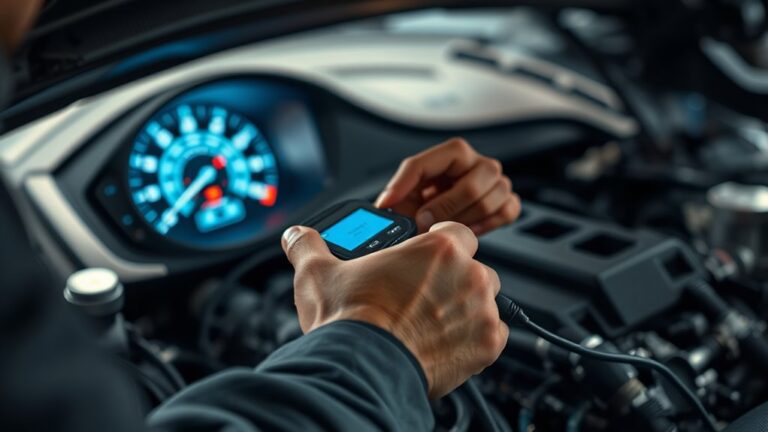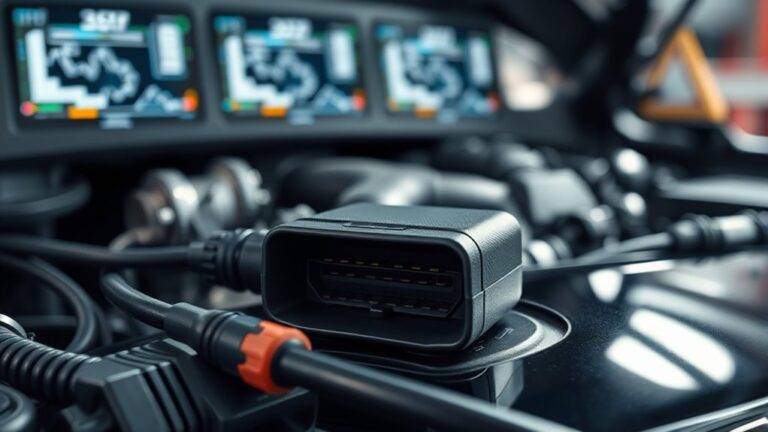How to Clear False Codes and Stop ECU Going to Safe Mode From Returning
To clear false codes and stop the ECU from returning to Safe Mode, you start by verifying reproducibility and isolating the fault. Next, systematically test sensor signals and wiring, inspecting connectors, resistance values, and harness integrity. Only clear codes after confirming a root cause, documenting every action. Recheck live data post-clearance and maintain a fault-trace log. Implement ongoing monitoring, calibration discipline, and safe rollback plans to prevent recurrence; more steps await to boost your confidence.
Diagnosing False Fault Codes Without Risk

When diagnosing false fault codes, begin by verifying that the codes are consistently reproducible and not a transient sensor glitch. You’ll approach this with discipline: reproduce, document, and compare results across cycles. Focus on false code triggers that reappear under stable conditions, not during startup transients. Use diagnostic tools to log live data, watch for erratic readings, and isolate likely culprits through controlled testing. Maintain a clear separation between ambient factors and actual faults, noting vehicle state, load, and fault timing. If a code persists without correlating sensor behavior, suspend conclusions and widen the data window before acting. Prioritize reproducibility over speculation, and corroborate findings with multiple sessions. Keep records concise: code, conditions, and observed anomalies. This method minimizes risk, preserves system integrity, and keeps your freedom to decide based on verifiable evidence, rather than rumor or assumption. Eventually, you’ll distinguish true faults from false code triggers with confidence, leveraging precise diagnostic tools.
Verifying Sensor Signals and Wiring Integrity

Verifying sensor signals and wiring integrity starts with systematic checks of signal paths and connector health. You’ll map each sensor’s path from the ECU input to the physical sensor, confirming continuity, shielding integrity, and impedance compatibility. Use a multimeter to validate resistance values against spec, and employ a scan tool to compare live vs. expected voltage and frequency ranges under steady and dynamic conditions. Detect intermittent connections by wiggling harnesses and re-seating connectors, noting any correlation with fault codes. For wiring diagnostics, inspect harness routing for chafed insulation, pin damage, corrosion, and grounding integrity; repair or replace as needed. Perform sensor calibration where required, affirming reference voltages align with factory standards and temperatures. Document any variance and re-test to confirm stability. Maintain clean grounds, validate proper signal filtering, and ascertain connector seals resist moisture ingress. This disciplined approach reduces false positives and keeps the system responsive rather than reactive.
Clearing Codes: Safe Procedures and Precautions

Having confirmed sensor signals and wiring integrity, you’ll now address clearing codes with a focus on safety and accuracy. You proceed with disciplined steps: verify fault cause, isolate the subsystem, then perform code clearance using approved procedures. Emphasize code clearance techniques that restore baseline readings without masking faults. Follow safety protocols: disconnect power when required, use proper tooling, and document every action. Validate after clearing by rechecking live data and attempting a controlled restart. If codes reappear, stop and reassess rather than force a reset. Maintain a record log for traceability and future diagnosis. This approach respects freedom by empowering you with precise control over the process while prioritizing safety and reliability.
| Benefit of careful clearance | Risk of rushing clearance |
|---|---|
| Confidence in results | Recurring faults or safety hazards |
| Clear documentation | Hidden issues escalate |
| Repeatable procedure | Data loss or misinterpretation |
| Compliance with standards | Noncompliant work |
| Peace of mind | Unnecessary downtime |
Preventing Safe-Mode Triggers: Maintenance and Updates
To prevent safe-mode triggers, implement a disciplined maintenance and update routine that keeps the ECU’s software and hardware interfaces within specification. You should perform routine inspections to verify wiring integrity, sensor calibration, and connector cleanliness, ensuring all signals stay within expected ranges. Establish a cadence for software updates that aligns with manufacturer releases and field data, applying patches only after validation in a controlled environment. Maintain a change log detailing firmware versions, calibration changes, and observed performance metrics, so you can trace any anomaly back to its source. Regular diagnostic scans should focus on error codes related to communication, input stability, and actuator response, prioritizing root-cause analysis over symptom masking. Emphasize documented procedures for safe reprogramming, secure boot, and rollback options to minimize downtime. By combining routine inspections with disciplined software updates, you reduce the likelihood of transient faults triggering safe mode while preserving system freedom and reliability.
Long-Term Strategies to Stabilize ECU Behavior
Long-term stabilization of ECU behavior hinges on systematic design choices, data-driven validation, and disciplined governance of firmware, calibration, and interfaces. You pursue repeatable processes: document requirements, define thresholds, and codify decision criteria so behavior isn’t guesswork. Establish a robust calibration regime that prioritizes traceable changes, versioned profiles, and rollback pathways, so you can recover from drift or unintended side effects. Embrace ECU tuning as an ongoing discipline, not a one-off patch, pairing live data with synthetic testing to expose corner cases before deployment. Schedule deliberate software updates that emphasize compatibility, minimal disruption, and clear changelogs, ensuring each release improves stability without compromising safety or performance. Implement automated monitoring, anomaly detection, and rapid rollback mechanisms to maintain momentum when anomalies appear. Maintain a culture of disciplined governance while preserving the freedom to innovate, balance risk and reward, and keep the system responsive to evolving operating conditions.
Frequently Asked Questions
Can False Codes Recur After ECU Reset and How to Prevent It?
Yes, false codes can recur after an ECU reset if the underlying sensor faults or wiring issues remain. To prevent it, identify false code causes, repair or replace faulty sensors, and secure connections. Perform a thorough diagnostic after reset, verify fuel, air, and ignition systems, and clear codes once confirmed. Use preventive measures like moisture protection, secure harnesses, and updated software. Regular monitoring helps you maintain freedom from recurring false codes.
Are There Risks in Using Aftermarket Tools to Clear Codes?
Yes, there are risks in using aftermarket tools to clear codes. You might disrupt ECU logic or worsen faults if the tool isn’t calibrated for your model. An anecdote: a hobbyist’s reader failed to interpret a live sensors result and cleared a significant code, masking an impending issue. You should weigh aftermarket reliability and diagnostic accuracy; verify tools against OEM specs, and cross-check with a reputable scanner to avoid masking problems. Proceed cautiously.
How Often Should ECU Software Be Updated for Stability?
ECU updates should be performed as needed for stability, not on a fixed schedule. You’ll want to monitor reliability after each module revision, prioritizing critical drivetrain and safety firmware. Aim for updates when you notice anomalies, degraded performance, or new features that enhance stability. Keep a changelog, verify compatibility, and test under representative conditions. Regular reviews of software stability notes help you decide cadence, ensuring you maintain performance without unnecessary risk or downtime.
Will Battery Voltage Fluctuations Trigger Safe Mode After Repair?
Yes, battery voltage fluctuations can trigger safe mode after repair. You should prioritize battery maintenance and monitor voltage stability to prevent repeats. Check the charging system, confirm proper ground connections, and keep alternator output within spec. If voltages dip below ~12.4–12.6V at idle, investigate parasitic drains and cable integrity. Regularly test with a multimeter, replace aged cells, and maintain electrolyte levels where applicable. Consistent voltage stability supports reliable ECU operation and freedom from fault-induced safeties.
Do Temp Changes Affect Sensor Readings and False Codes Generation?
Around 0.5% of live sensor readings slip due to temperature shifts, you’ll notice that. Do temp changes affect sensor readings and false code generation? Yes, they can, because temperature sensitivity alters calibration. You’ll want solid sensor calibration and awareness of temperature sensitivity when diagnosing. Keep temperature-stable test conditions, verify calibration against known references, and account for drift. If readings deviate, recalibrate promptly to maintain reliable, freedom-loving performance.





